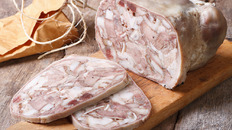Meats and Sausages
Queso de Cabeza (Head Cheese)
| Meats | Metric | US |
|---|---|---|
| Pork meat rich in connective tissue* | 1000 g | 2.2 lb |
Ingredients per 1000g (1 kg) of meat
| Salt | 15 g | 2-1/2 tsp |
| Peppercorns | 4.0 g | 2 tsp |
| Cayenne | 1.0 g | 1/2 tsp |
| Onion | 60 g | 2 oz |
| Garlic | 10 g | 3 cloves |
| Bay leaf | 1 leaf | |
| Celery | 1 stalk | |
| Leek | 1 stalk | |
| Parsnip | 1 root | |
| Carrot | 1 | |
| Oregano, rubbed | 10 g | 1 Tbsp |
| White wine | 60 ml | 2 oz fl |
Instructions
- Place all meats in a suitable pot, add leek, celery, parsnip, carrot, onion, peppercorns and cover with 1 inch of water and wine. Bring to a boil and simmer below boiling point until meats are soft and the bones are easily removable.
- Drain the meats, spread on the table and allow to cool. Save meat stock, discard vegetables.
- When the meats are still warm, separate the meat from the bones. Cut larger chunks into smaller pieces, cut the skins into strips.
- Mix meats with salt, garlic, oregano, cayenne adding about 1/2 cup (125 ml) of the meat stock. This meat stock is a naturally produced gelatin.
- Using a ladle stuff the mixture loosely into pork stomachs or large diameter synthetic casings.
- Cook in water at 80° C (176° F) for 90-120 min (depending on the size) until meat reaches 68-70° C (154-158° F) internal temperature.
- Spread head cheeses on a flat surface and let the steam out. Flatten with weight and cool to 6° C (43° F) or lower.
- Clean head cheeses of any fat and aspic that accumulated on the surface and cut off excess twine.
- Keep refrigerated.
Notes
* head, leg meat, pork skins, snouts, meats with connective tissue.
Eat cold with a roll and lemon juice or vinegar.
Eat cold with a roll and lemon juice or vinegar.


















